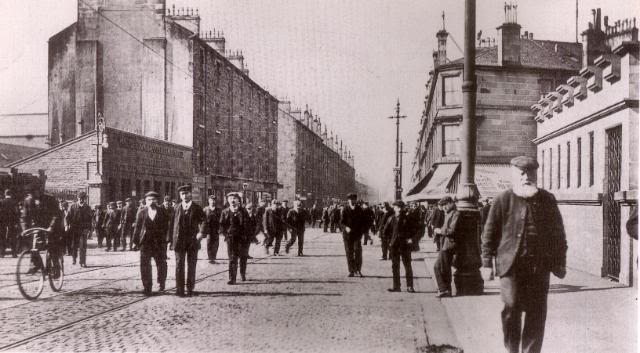Patrick Docherty (1884-1956)
Patrick Docherty
,
son of John Docherty (1862-1916) and Bridget Toole Docherty (1865-1927) was born in 1884 in Dumbarton.
Patrick's parents continued to live in Dumbarton for the remainder of their lives. Patrick's
father John was a Clydeside Riveter - a profession in which Patrick was to follow.
Patrick married Jeanie Townsley Docherty, who was a steam loom weaver at the time, on the 2nd January 1905 at the St James Roman
Catholic Church in Renfrew.
Together they had at least 7 children, who all retained their mother's maiden name:
- Andrew Townsley Docherty (1916-1966)
- Mary Townsley Docherty (1907-1916)
- John Townsley Docherty (1910-tbc)
- Daniel Docherty (1912-1969)
- Robert Townsley Docherty (1918-1999)
- William Townsley Docherty (1921-1999)
- Jeanie Townsley Docherty (1923-tbc)
Patrick's daughter and first child Mary, was sadly to die aged only 8 years old on the 22nd January 1916 from acute meningitis with Patrick being the Informant. Their second son Andrew was however born soon after on the 10th February 1916. The marriage certificate of Patrick and Jeanie notes that Patrick was living at Old Kilpatrick in Clydebank aged 20 with Jeanie living at 21 Croft Place Renfrew. A Susan Docherty (presently untraced family member) acted as witness.
 |
 |
||
| West Bridgend, Dumbarton where Patrick grew up | St James Catholic Church where Patrick and Jeanie married in 1905 | ||
Patrick's profession as a Clydeside riveter was recognised as a dangerous job where closely co-ordinated 'squads' would work long hard hours where work was available. There was no security of employment and pay rates were highly variable - being linked to output. A contemporary aticle by James Watt decribes the Riveter profession in vivid terms:
Riveting was one of the most physically demanding of all the shipbuilding trades. "The riveters worked in four-man squads", he said. "Two men wielded heavy, long-headed hammers, one right-handed and the other left-handed, while another, known as a holder-on, had to dolly the rivet head. The team also included a boy whose job was to heat the rivets white hot. The hammermen worked at such a tremendous speed that their blows sounded like machine guns. Speed was vital. The base of the rivet had to be hammered flat so that when it cooled its contraction drew the steel plates together so tightly that they formed a waterproof seal. In those days ships were built frame-by-frame and plate-byplate and hundreds of thousands of rivets were used to hold them all together. The ships were all built out in the open and the men were expected to continue working in all weather, summer and winter. It was a ferocious workplace in winter. Men worked down by the riverside with a bitter northerly wind coming over the snow-covered high ground. They were always very badly clothed. There was no concept of health and safety in the shipyards and for the most part the men were very ill-clad for the job. They had no industrial clothing. It was all cloth caps and old tweed suits". It was work that bred a very hardy race of men. James Watt remembers them as "small and tough and wiry". Most were around five feet six inches tall and although many were much shorter, they had the upper bodies of very big, powerful men.
The John Brown and Company Marine Engineering and Shipbuilding firm of Clydebank was one of the most highly regarded international shipbuilding companies. At their height from 1900-1950, they were responsible for such notable ships as the RMS Lusitania, the RMS Queen Mary, RMS Queen Elizabeth and the RMS Queen Elizabeth II (generally referred to as the QE2).
 |
 |
||
| The John Brown Shipyard Gates through which Patrick would have passed daily | John Brown's flagship RMS Aquitania from 1913 - a ship Patrick would likely have worked on | ||
Patrick lived until the age of 72 years, outliving his wife Jeanie who had succumbed to bronchitis during the exceptionally harsh winter of 1947. He passed away whilst living at 5 Ferguson Street Renfrew from circulatory failure on the 20th September 1956. The Informant was his son Daniel, who was living at 115 Paisley Road Renfrew.
Family Tree Summary
| Forename | Surname | Born | Died | Cause of Death |
| Patrick | Docherty | 1884 | 20/09/1956 | Circulatory Failure |